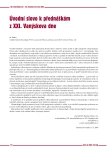Post transfusion reactions
Authors:
B. Kubešová; E. Tesařová
Authors‘ workplace:
Transfuzní oddělení a krevní banka FN Brno, pracoviště Bohunice, přednosta prim. MUDr. Eva Tesařová
Published in:
Vnitř Lék 2005; 91(7 a 8): 905-908
Category:
128th Internal Medicine Day - 21rd Vanysek's Day Brno 2005
Overview
Post transfusion reaction (PTR) is understood as an adverse effect of application of a transfusion product. The risk of some PTRs may be minimalized by the GMP (Good Manufacturing Practice) and by its appropriate processing in the stage of clinical application (blood drawing and identification of the sample, proper fill in of the application formulary, appropriate handling with the product, including the application of the product to the patient). Some of the PTRs may be influenced by preventive means (deleukotization, irradiation), the others may be minimalized only by bearing them in mind with the possibility of starting the diagnostic and therapeutic measures as soon as possible. According to the practice aim of this paper the authors selected the hemolytic PTR for the detailed description. There is one fatal hemolytic PTR per a year in the Czech Republic as a mean. The hemolytic PTR may be caused also by non-immunologic mechanisms (the damage of the erythrocytes), and these causes are relatively unrecognized. The febrile PTR comes quite frequently in the clinical practice and it may be prevented by the deleukotization by the great deal. The allergic PTRs commonly do not create serious problems in the transfusion practice, but if there is a heavy allergic or anaphylactic reaction in the anamnesis of the concrete patient, it is necessary to eliminate the plasmatic proteins from the cellular products before they are used. The not uniformly known TAGvHD has very serious prognosis but may be relatively easily prevented, and that is why it should be realized by the whole health care professionals’ community.
Key words:
post transfusion reactions - prevention - TA-GvHD
Sources
1. Písačka M. Doporučený postup při předtransfuzním laboratorním vyšetření. Transfuze dnes 1999; 27-28: 2-11.
2. Spiess BD. Risk of transfusion outcome focus. Transfusion 2004; 44: 4-14.
3. Murphy M, Pamphilon D. Practical Transfusion Medicine. 1. ed. London: MPG Books 2002.
4. Sweeney J. Clinical Transfusion Medicine. 1. ed. New York: Landes Bioscience 1999.
5. Mollison P, Engelfried C et al. Blood Transfusion in Clinical Medicine. 10. ed. London: Bath Press 1997.
Labels
Diabetology Endocrinology Internal medicineArticle was published in
Internal Medicine

2005 Issue 7 a 8
Most read in this issue
- Post transfusion reactions
- Thrombocytosis and thrombocythemia
- Antiphospholipid syndrome – diagnosis and treatment
- Anemia of chronic disease
